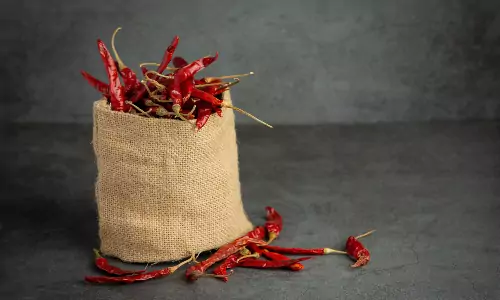Origin and Worldwide Distribution
Red chilli exporters in India say chilli is native to South America and is distributed mainly in tropical and subtropical countries, including India. The Portuguese brought it to India towards the end of the 15th Century. At present, it is grown all over the world, excluding the colder regions.

Worldwide Export Scenario from India
India is recognized as the world’s biggest exporter of dry red chilli, and its value exports have steadily risen over the last 1.5 decades – from 1.01 lakh MT to FY2020 to 5 lakh MT.
A decade ago, Sri Lanka and Malaysia were India’s top two dry red chilli exporters. China, Thailand and Vietnam have replaced their positions today, accounting for the lion’s share of this multi-million dollar worth of exports from Guntur, Andhra Pradesh, India.
Between 2005 and 2008, China held the prestigious title of the world’s top chilli exporter. In the most recent half-decade, China’s chilli output has experienced a lamentable decline, attributed to a reorientation of priorities and agricultural setbacks. Stepping into the spotlight, India now claims the coveted No.1 spot, with China increasingly turning to its neighbor for sourcing and procurement. Consequently, Indian exports have been on a remarkable ascent, marking a significant global chilli trade outlook.
Once reliant on imports from China, Asian nations such as Indonesia, Malaysia, and Singapore have shifted their gaze towards India as a prime source for their vast requirements. Amidst China’s dwindling exports, these countries now tap into substantial quantities from the Indian market.
Even in Mexico, renowned for its plethora of chilli varieties and status as the world’s leading chilli producer, the demand for Teja from Guntur has surged. With its fiery potency ranking second only to Assam Joloka, Teja reigns supreme in international markets due to its widespread availability compared to its scarce counterpart. Not confined to culinary use alone, Teja finds utility in paints, serving as an effective insect deterrent.
While Chinese varieties boast vibrant hues, they lack the robust pungency of Teja. Consequently, there’s a burgeoning trend of hybridization, with Teja reaching China for crossbreeding endeavors, potentially altering the chilli industry in unforeseen ways.
Red chilli supplier in India says the spice is scientifically known as:
- Capsicum annum L
- Capsicum frutescens L
- Solanaceae Green, ripe and dried pod (fruit)
Dry red Chilli Name in international languages
- Arabic: Filfil Ahmar
- British: Chillies(Hot) Pepper (Sweet)
- Chinese: Hesiung Yali chiao
- Dutch: Spaanse Peper
- French: Puvre de Guinee
- German: Paprika
- Italian: Peperone
- Japanese: Togarashi
- Portuguese: Pimento
- Russian: Struchkovy pyeret
- Spanish: Pimenton
Indian Scenario
With the domestic-to-export market ratio of 60:40, India’s total production is between 12 and 40 lakh MT/annum, and Guntur’s contribution is between 50 and 60%. Everything coming to the market is sold out yearly because stocks that have yet to be brought forward are available.
After the coronavirus pandemic, dry red chilli exports from India have risen smartly compared to when the procedure was at a standstill for months. For the Teja variety, prospects look favorable due to the uptrend in China procurement. Due to demand and pricing factors, Teja is inevitably compared to Guntur’s other red chilli grades. The high spice and dark red colour exuded by Teja makes it costlier than other varieties. An array of varieties is constantly in demand in the market, but all of those require the kind of price Teja does.
Note: The intensity of colour, spice and supply-demand determine the cost of dry red chilli.
Indian Names
- Bengali: Lanka, Lankamorich
- Gujarati: Marcha
- Hindi: Lal mirch
- Kannada: Mensina kai
- Malayalam: Mulaku
- Marathi: Mirchi
- Oriya: Lanka
- Punjabi: Lalmirch
- Tamil: Milagay
- Telugu: Mirapa kaya
- Urdu: Lalmirch
Dry Red Chilli Uses & Benefits
- Curried dishes such as curry powder use dry chilli extensively.
- Hot sauces like pepper sauce and Tabasco sauce are prepared using this spice.
- Warangal chapatta, Paprika, and Bydagi chilly and less-pungent varieties of similar high colour are widely used for colour extraction. Paprika works as a colourant among food and beverage processors due to its natural plant colour property.
- Dry red chilli exporters say the Teja varieties make sumptuous additions to pickles and pizzas for global consumers.
- Lumbago, neuralgia, and Rheumatic disorders use it as a curing counterirritant medicine. The enzyme isolated from red chillies can be used to treat certain kinds of cancers. Red chilli suppliers in India say capsicum’s tonic and carminative action causes gastroenteritis when consumed inordinately. As pain balms and vaporubs, oleoresin capsicum works best with dehydrated green chillies as a great source of vitamin C.
Understanding the nuances of dry red chillies is crucial for anyone who appreciates flavour and spice in their culinary adventures. Whether a seasoned chef or an amateur cook, grasping these essential insights into dry red chillies can elevate your dishes and enrich your gastronomic journey. To know more about red chilli in India, get in touch with Vora Spice Mills today.
Vora Spice Mills, a top dry red chilli exporter and manufacturer in India, ensures top-notch quality by directly sourcing raw materials from agro farms. With zero contamination risks in production, their products guarantee the finest culinary experience.


